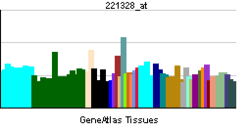CLDN17
Claudin-17 is a protein that in humans is encoded by the CLDN17 gene.[3][4] It belongs to the group of claudins. It forms anion-selective paracellular channels and is localized mainly in kidney proximal tubules.[5]
References
- ↑ "Human PubMed Reference:".
- ↑ "Mouse PubMed Reference:".
- ↑ Katoh M, Katoh M (May 2003). "CLDN23 gene, frequently down-regulated in intestinal-type gastric cancer, is a novel member of CLAUDIN gene family". Int J Mol Med. 11 (6): 683–9. doi:10.3892/ijmm.11.6.683. PMID 12736707.
- ↑ "Entrez Gene: CLDN17 claudin 17".
- ↑ Krug SM, Günzel D, Conrad MP, Rosenthal R, Fromm A, Amasheh S, Schulzke JD, Fromm M (2012). "Claudin-17 forms tight junction channels with distinct anion selectivity". Cell Mol Life Sci. 69 (16): 2765–78. doi:10.1007/s00018-012-0949-x. PMID 22402829.
Further reading
- González-Mariscal L, Betanzos A, Nava P, Jaramillo BE (2003). "Tight junction proteins.". Prog. Biophys. Mol. Biol. 81 (1): 1–44. doi:10.1016/S0079-6107(02)00037-8. PMID 12475568.
- Tsukita S, Furuse M (2003). "Claudin-based barrier in simple and stratified cellular sheets.". Curr. Opin. Cell Biol. 14 (5): 531–6. doi:10.1016/S0955-0674(02)00362-9. PMID 12231346.
- Tsukita S, Furuse M, Itoh M (2001). "Multifunctional strands in tight junctions.". Nat. Rev. Mol. Cell Biol. 2 (4): 285–93. doi:10.1038/35067088. PMID 11283726.
- Heiskala M, Peterson PA, Yang Y (2001). "The roles of claudin superfamily proteins in paracellular transport.". Traffic. 2 (2): 93–8. doi:10.1034/j.1600-0854.2001.020203.x. PMID 11247307.
- Kniesel U, Wolburg H (2000). "Tight junctions of the blood–brain barrier.". Cell. Mol. Neurobiol. 20 (1): 57–76. doi:10.1023/A:1006995910836. PMID 10690502.
- Hu YH, Warnatz HJ, Vanhecke D, et al. (2006). "Cell array-based intracellular localization screening reveals novel functional features of human chromosome 21 proteins.". BMC Genomics. 7: 155. doi:10.1186/1471-2164-7-155. PMC 1526728
 . PMID 16780588.
. PMID 16780588.
- Gerhard DS, Wagner L, Feingold EA, et al. (2004). "The status, quality, and expansion of the NIH full-length cDNA project: the Mammalian Gene Collection (MGC).". Genome Res. 14 (10B): 2121–7. doi:10.1101/gr.2596504. PMC 528928
 . PMID 15489334.
. PMID 15489334.
- Clark HF, Gurney AL, Abaya E, et al. (2003). "The secreted protein discovery initiative (SPDI), a large-scale effort to identify novel human secreted and transmembrane proteins: a bioinformatics assessment.". Genome Res. 13 (10): 2265–70. doi:10.1101/gr.1293003. PMC 403697
 . PMID 12975309.
. PMID 12975309.
- Strausberg RL, Feingold EA, Grouse LH, et al. (2003). "Generation and initial analysis of more than 15,000 full-length human and mouse cDNA sequences.". Proc. Natl. Acad. Sci. U.S.A. 99 (26): 16899–903. doi:10.1073/pnas.242603899. PMC 139241
 . PMID 12477932.
. PMID 12477932.
- Brandner JM, Kief S, Grund C, et al. (2003). "Organization and formation of the tight junction system in human epidermis and cultured keratinocytes.". Eur. J. Cell Biol. 81 (5): 253–63. doi:10.1078/0171-9335-00244. PMID 12067061.
- Hattori M, Fujiyama A, Taylor TD, et al. (2000). "The DNA sequence of human chromosome 21.". Nature. 405 (6784): 311–9. doi:10.1038/35012518. PMID 10830953.
- Liu F, Koval M, Ranganathan S, Fanayan S, Hancock WS, Lundberg EK, Beavis RC, Lane L, Duek P, McQuade L, Kelleher NL, Baker MS (2015). "A systems proteomics view of the endogenous human claudin protein family". J Proteome Res. doi:10.1021/acs.jproteome.5b00769. PMID 26680015.

 . PMID 16780588.
. PMID 16780588. . PMID 15489334.
. PMID 15489334. . PMID 12975309.
. PMID 12975309. . PMID 12477932.
. PMID 12477932.